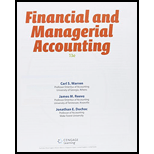
Concept explainers
1. (a)
Methods of
The three methods of depreciation are:
- Straight-line method: Under the straight-line method of depreciation, the same amount of depreciation is allocated every year over the estimated useful life of an asset.
- Units-of-activity method: In this method of depreciation, the amount of depreciation is charged based on the unit of production each year.
- Double-declining balance method (Accelerated method): In this method of depreciation, the diminishing value of the asset is taken into consideration for determining the depreciation for the succeeding years.
the amount of depreciation for four years ending December 31 by straight-line method.
1. (a)
Explanation of Solution
Determine the amount of depreciation for four years ending December 31 by straight-line method.
| Year | Depreciation Expense (1) |
| 2015 | $71,250 |
| 2016 | $71,250 |
| 2017 | $71,250 |
| 2018 | $71,250 |
| Total | $285,000 |
Table (1)
Working note:
Compute depreciable expense under
Cost of the equipment= $320,000
Residual value of the equipment = $35,000.
Estimated Useful life of the equipment = 4 years
Therefore, the amount of depreciation for four years ending December 31 by straight-line method is $71,250.
(b)
the amount of depreciation for four years ending December 31 by units-of-activity method.
(b)
Explanation of Solution
Determine the amount of depreciation for four years ending December 31 by units-of-activity method.
| Year | Number of Hours (A) | Depreciable Rate (B) (2) | Depreciation Expense (A×B) |
| 2015 | 7,200 | $14.25 | $102,600 |
| 2016 | 6,400 | $14.25 | $91,200 |
| 2017 | 4,400 | $14.25 | $62,700 |
| 2018 | 2,000 | $14.25 | $28,500 |
| Total | $285,000 |
Table (2)
Working notes:
Determine the depreciable rate of the equipment.
Cost of the equipment= $320,000
Residual value of the equipment = $35,000.
Estimated Useful life of the equipment = 20,000 operating hours.
Therefore, the amount of depreciation for four years ending December 31 by units-of-activity method are 2015: $102,600, 2016: $91,200, 2017: $62,700, and 2018: $28,500.
(c)
the amount of depreciation for four year years ending December 31 by double-declining-balance method.
(c)
Explanation of Solution
Determine the amount of depreciation for four years ending December 31 by double-declining-balance method.
| Year | Depreciable Expense |
| 2015 | $160,000 (3) |
| 2016 | $80,000 (4) |
| 2017 | $40,000 (5) |
| 2018 | $5,000 (6) |
| Total | $285,000 |
Table (3)
Working notes:
Compute depreciable expense for 2015.
Compute depreciable expense for 2016.
Compute depreciable expense for 2017.
Compute depreciable expense for 2018.
Note (6):
Since the depreciation expense should not exceed the residual value of $35,000. Thus, it should be adjusted to make the book value of the equipment (cost less accumulated depreciation) equal to its residual value. Thus, the depreciation expense for 2018 would be
Therefore, the amount of depreciation for four years ending December 31 by double-declining-balance method are 2015: $160,000, 2016: $80,000, 2017: $40,000, and 2018: $5,000.
2.
the method that yields the highest depreciation expense for 2015.
2.
Explanation of Solution
The method that yields the highest depreciation expense for 2015 is double-declining-balance method that is, $160,000.
3.
the method that yields the most depreciation over the four-year life of the equipment.
3.
Explanation of Solution
As calculated above, the total depreciation expense under three method for the four-year life of the equipment is same, that is, $285,000. Thus, it cannot be determined.
Want to see more full solutions like this?
Chapter 9 Solutions
Bundle: Financial & Managerial Accounting, Loose-Leaf Version, 13th + CengageNOWv2, 2 terms Printed Access Card
- Can you provide a detailed solution to this financial accounting problem using proper principles?arrow_forwardCould you help me solve this financial accounting question using appropriate calculation techniques?arrow_forwardPlease explain the solution to this general accounting problem with accurate explanations.arrow_forward
- Brown Corporation has 850 defective units of a product that cost $4.25 per unit in direct costs and $8.40 per unit in indirect costs when produced last year. The units can be sold as scrap for $5.30 per unit or reworked at an additional cost of $2.75 per unit and sold at the full price of $14.90. The incremental net income (loss) from the choice of reworking the units would be____.arrow_forwardWhat is the profit margin?arrow_forwardPlease provide the accurate answer to this general accounting problem using appropriate methods.arrow_forward
- Calculate the predetermined overhead allocation rate using each of the four possible allocation based providedarrow_forwardAndy Manufacturing produces plastic and metal kitchen utensils. In preparing the current budget, Andy's management estimated a total of $380,000 in manufacturing overhead costs and 19,000 direct labor hours for the coming year. In December, Andy's accountants reported actual manufacturing overhead incurred of $93,000 and 18,200 direct labor hours used during the year. Andy applies overhead based on direct labor hours. Required: What was Andy's predetermined overhead rate for the year? How much manufacturing overhead did Andy apply during the year?arrow_forwardWhat is the correct option ? for general accounting questionarrow_forward
 College Accounting, Chapters 1-27AccountingISBN:9781337794756Author:HEINTZ, James A.Publisher:Cengage Learning,
College Accounting, Chapters 1-27AccountingISBN:9781337794756Author:HEINTZ, James A.Publisher:Cengage Learning, Cornerstones of Financial AccountingAccountingISBN:9781337690881Author:Jay Rich, Jeff JonesPublisher:Cengage Learning
Cornerstones of Financial AccountingAccountingISBN:9781337690881Author:Jay Rich, Jeff JonesPublisher:Cengage Learning Financial Accounting: The Impact on Decision Make...AccountingISBN:9781305654174Author:Gary A. Porter, Curtis L. NortonPublisher:Cengage LearningPrinciples of Accounting Volume 1AccountingISBN:9781947172685Author:OpenStaxPublisher:OpenStax College
Financial Accounting: The Impact on Decision Make...AccountingISBN:9781305654174Author:Gary A. Porter, Curtis L. NortonPublisher:Cengage LearningPrinciples of Accounting Volume 1AccountingISBN:9781947172685Author:OpenStaxPublisher:OpenStax College EBK CONTEMPORARY FINANCIAL MANAGEMENTFinanceISBN:9781337514835Author:MOYERPublisher:CENGAGE LEARNING - CONSIGNMENT
EBK CONTEMPORARY FINANCIAL MANAGEMENTFinanceISBN:9781337514835Author:MOYERPublisher:CENGAGE LEARNING - CONSIGNMENT





